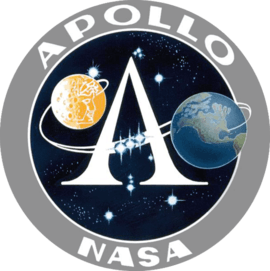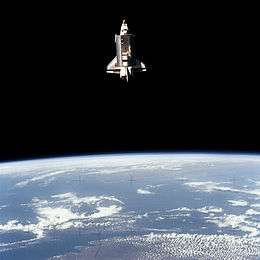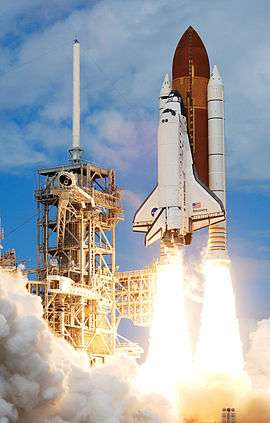Crawler-transporter
| Crawler-transporter | |
|---|---|
 | |
| Overview | |
| Manufacturer | Marion Power Shovel Company |
| Also called | Missile Crawler Transporter Facilities |
| Model years | 1965 |
| Powertrain | |
| Engine |
2 × 2,050 kW (2,750 hp) V16 ALCO 251C diesel engines 2 × 750 kW (1,006 hp) generators, driven by two 794 kW (1,065 hp) engines, are used for jacking, steering, lighting, and ventilating. |
| Transmission | 16 × traction motors, powered by four 1,000 kW (1,341 hp) generators |
| Dimensions | |
| Length | 40 m (131 ft) |
| Width | 35 m (114 ft) |
| Height | Adjustable, 6 to 8 m (20 to 26 ft) |
| Curb weight | 2,721 t (6,000,000 lb)[1] |
|
Missile Crawler Transporter Facilities | |
| Location | Kennedy Space Center, Florida |
| MPS | John F. Kennedy Space Center MPS |
| NRHP Reference # | 99001643[2] |
| Added to NRHP | January 21, 2000 |
The crawler-transporters, formally known as the Missile Crawler Transporter Facilities,[2] are a pair of tracked vehicles used to transport spacecraft from NASA's Vehicle Assembly Building (VAB) along the Crawlerway to Launch Complex 39. They were originally used to transport the Saturn IB and Saturn V rockets during the Apollo, Skylab and Apollo–Soyuz programs. They were then used to transport Space Shuttles from 1981 to 2011. The crawler-transporters carry vehicles on the Mobile Launcher Platform, and after each launch return to the pad to take the platform back to the VAB.[3]
The two crawler-transporters were designed and built by Marion Power Shovel Company using components designed and built by Rockwell International at a cost of US$14 million each.[4] Upon its construction, the crawler-transporter became the largest self-powered land vehicle in the world. While other vehicles such as bucket-wheel excavators like Bagger 293, dragline excavators like Big Muskie and power shovels like The Captain are significantly larger, they are powered by external sources.
The two crawler-transporters were added to the National Register of Historic Places on January 21, 2000.[2]
Specifications
The crawler-transporter has a mass of 2,721 tonnes (6,000,000 lb) and has eight tracks, two on each corner.[1] Each track has 57 shoes, and each shoe weighs 900 kg (1,984 lb). The vehicle measures 40 by 35 metres (131 by 114 ft). The height from ground level to the platform is adjustable from 6.1 to 7.9 m (20 to 26 ft), and each side can be raised and lowered independently of the other. The crawler uses a laser guidance system and a leveling system to keep the Mobile Launcher Platform level within 10 minutes of arc (about 30 cm (1 ft) at the top of the Saturn V), while moving up the 5% grade to the launch site.[5] A separate laser docking system provides pinpoint accuracy when the crawler-transporter and Mobile Launch Platform are positioned in the VAB or at the launch pad.[6] A team of nearly 30 engineers, technicians and drivers operate the vehicle.[7]

The crawlers were overhauled in 2003 with upgrades to the Motor Control Center, which houses the switchgear and electrical controls of all of major systems on board, a new engine and pump ventilation system and new diesel engine radiators, and replacement of the two driver cabs on each vehicle (one on each end).[7] As of 2003, each crawler had 16 traction motors, powered by four 1,000 kW (1,341 hp) generators, in turn driven by two 2,050 kW (2,750 hp) V16 ALCO 251C diesel engines. Two 750 kW (1,006 hp) generators, driven by two 794 kW (1,065 hp) engines, were used for jacking, steering, lighting, and ventilating. Two 150 kW (201 hp) generators were also available to power the Mobile Launcher Platform. The crawler's tanks held 19,000 liters (5,000 U.S. gal) of diesel fuel, and it burned 296 liters per kilometer (125.7 U.S. gal/mi).[1] Due to its age and the need to support the heavier Space Launch System and its launch tower, in mid-2012 one of the crawlers was undergoing an upgrade involving "new engines, new exhausts, new brakes, new hydraulics, new computers," to increase its lifting capacity from 5,400,000 to 8,200,000 kg (12,000,000 to 18,000,000 lb).[4]
The crawler is controlled from two control cabs located at either end of the vehicle, and travels along the 5.6 km (3.5 mi) crawlerway at a maximum speed of 1.6 km/h (1 mph) loaded, or 3.2 km/h (2 mph) unloaded. The average trip time from the VAB along the Crawlerway to Launch Complex 39 is about five hours.[1] Each crawlerway is 2 m (7 ft) deep and covered with Alabama and Tennessee river rock for its low friction properties to reduce the possibility of sparks. In 2000, NASA unearthed and restored an Apollo-era segment of the crawlerway to provide access to a high-bay building in order to provide protection from a hurricane.[8]
Kennedy Space Center has been using the same two crawlers, now nicknamed "Hans" and "Franz", since their initial delivery in 1965.[9] In their lifetime, they have traveled more than 5,500 km (3,400 mi), about the same driving distance as from Miami to Seattle.[7]
Appearances in popular culture
The crawler-transporters have featured in television and movies. In a season three episode of Dirty Jobs, host Mike Rowe helps workers maintain a crawler-transporter and takes the vehicle for a short drive.[10] The crawler was also seen in the 1995 film Apollo 13 and the 2011 film Transformers: Dark of the Moon. Similar vehicles appeared in the 2013 film Pacific Rim, used for transporting and launching Jaegers.
In the Fallout 3 video game add-on pack "Broken Steel", the US government survivors, The Enclave, have a mobile base built on and into a heavily modified crawler. In Sid Meier's Alpha Centauri, various units are called "crawlers" and feature chassis based on the crawler-transporters.
Gallery
 Crawlerway junction at the LC-39 observation gantry. The right track leads to pad LC-39A (pictured with the Space Shuttle Endeavour), while the left track leads to pad LC-39B.
Crawlerway junction at the LC-39 observation gantry. The right track leads to pad LC-39A (pictured with the Space Shuttle Endeavour), while the left track leads to pad LC-39B.
 Saturn-V on top of a crawler
Saturn-V on top of a crawler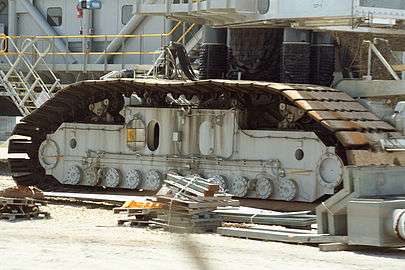 Detail of crawler treads
Detail of crawler treads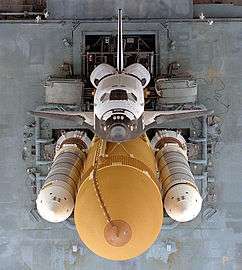
 Crawler carrying the Ares I-X
Crawler carrying the Ares I-X
References
- 1 2 3 4 "Crawler - Transporter". NASA.gov. April 21, 2003. Retrieved June 18, 2007.
- 1 2 3 Staff. "NPS Focus: 99001643". National Register of Historic Places. National Park Service.
- ↑ "Kennedy Prepares to Host Constellation". NASA.gov. September 28, 2007. Retrieved June 7, 2009.
- 1 2 Peddie, Matthew (September 5, 2012). "NASA's Historic Giant Crawler Gets a Tune Up for Modern Times (Pics)". Transportation Nation.
- ↑ "KSC-05PD-1322". NASA.gov. June 15, 2005. Retrieved June 18, 2007.
- ↑ "Countdown! NASA Launch Vehicles and Facilities". NASA.gov. October 1991. PMS 018-B. Retrieved June 18, 2007.
- 1 2 3 "Crawler Transporter" (PDF). Return to Flight Spotlight. NASA (1). April 2004. Archived from the original (PDF) on March 20, 2009.
- ↑ Halvorson, Todd (August 13, 2000). "Shuttle Safe Haven Opens at Kennedy Space Center". Space.com. Archived from the original on September 20, 2005.
- ↑ Sands, Jason (May 2007). "NASA's Diesel-Powered Shuttle Movers". Diesel Power.
- ↑ "The Complete Dirty Jobs Show Guide: 2007". Discovery.com. Archived from the original on October 12, 2012.
External links
| Wikimedia Commons has media related to Crawler-transporters. |
- 28°35′17″N 80°39′19″W / 28.58808°N 80.65521°W - Crawler-transporter parking area at Kennedy Space Center
- Virtual tour of Crawler Transporter 2 upgrades, September 3, 2014
